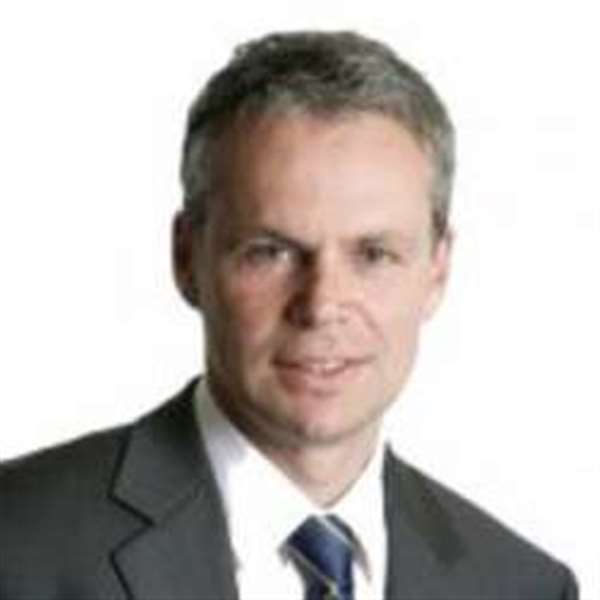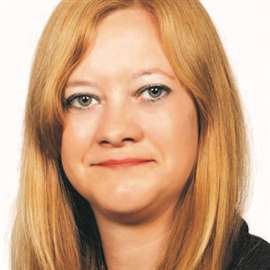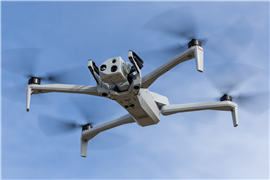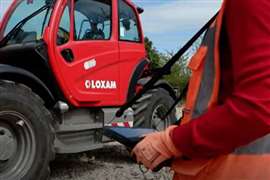Rental companies grapple with scope 3 emissions
16 October 2023
Rental companies around the world are coming under increasing pressure to cut the clouds of emissions produced by the machines they rent out. But how can rental firms even start to work out how much carbon their customers are burning, let alone encourage them to burn less? Lucy Barnard finds out.
Cédric Conrad, sustainable development director at Europe’s largest construction equipment rental company, Loxam is looking at a chart of all the different figures that go into calculating the firm’s carbon footprint.
In one hexagon-shaped bucket stands all of the 47,200 metric tons of carbon dioxide the company was responsible for producing in 2022, including heating and lighting its branches, delivering equipment to customers and even travelling for business.
 Cédric Conrad, sustainable development director at Loxam. Photo: Loxam
Cédric Conrad, sustainable development director at Loxam. Photo: Loxam
Around this Conrad and his team have highlighted some of the most significant steps the company has taken to reduce its energy consumption including supplying 95% of its French branches with renewable energy, transitioning its delivery fleet to include 14 gas-powered trucks and systematically fitting solar panels on the roofs of every new branch in the Netherlands.
In the other bucket, however, stands all of the carbon emissions that the group is indirectly responsible for – known as scope 3 emissions - covering all the emissions created by manufacturing the machines Loxam rents out and, more critically those created by customers when they use machines on their jobsites.
It is this second bucket, containing 896,800 metric tons of carbon dioxide gas and its equivalent – nearly twenty times that of the first – which is worrying Conrad the most.
“As a rental company, when you don’t think about your scope 3 emissions, basically you miss 95% of your total carbon footprint so it’s quite a big deal for rental companies,” he says.
Such multiples are not unusual in the industry. Loxam’s smaller rival Kiloutou reports direct emissions for 2022 of 27,035mtCO2e while its scope 3 emissions were nearly 14 times higher at 377,189mtCO2e.
For generator hire specialist Aggreko, scope 3 emissions make up an even bigger share of the company’s total carbon footprint. It reports that total 2022 greenhouse gas emissions ten times higher than those of Loxam at 9,131,606 metric tons of CO2 equivalent, of which scope 3 emissions make up a massive 99.4% of its total.
Until recently, most companies, including those in the equipment rental industry, have tended to focus their carbon emissions reduction targets on their direct emissions arguing that these are easier for them to both calculate and control.
However, as pressure from campaigners, consumers, employees, shareholders, funders and governments continues to mount on firms to reduce their overall carbon footprint, rental companies are coming under increasing pressure to get to grips with indirect emissions too.
This is especially the case for any company which wants to set an independently adjudicated ‘net zero’ emissions target because a net zero target must include indirect emissions.
In its latest sustainability report, United Rentals, the largest equipment rental company in the world, commits only to measuring scope 1 and 2 emissions as well as the emissions from third party hauling.
What are scope 3 emissions?
“Our scope 3 inventory process used estimates and assumptions based on spending data and calculations based on customer use. These have uncertainties and limitations including insufficient data from certain suppliers and suppliers unwilling or incapable of monitoring carbon emissions,” the company said in its report.
“Not all companies are disclosing scope 3 emissions which is normal,” says Conrad. “And even if you apply the same methodology, those which do disclose should be very careful about comparing scope 3 emissions because the business model of the company could impact quite a lot. It depends on the type of equipment you stock, the type of customers. Even if the differences are quite small in terms of turnover, it could be huge for the overall carbon footprint. We need to take all that into account.”
“It is better to talk about the decrease in emissions or the numbers of actions that you implement,” Conrad adds. “This you can compare from one company to another more easily than discussing the numbers of metric tons.”
The definition of Scope 3 emissions is laid out in the Greenhouse Gas Protocol, a joint initiative of World Resources Institute and the World Business Council for Sustainable Development first published in 2001. It specifies 15 categories, including purchased goods, waste generated, fuel related activities, use of sold products, investments, franchises and employee commuting.
Companies point out that for large organisations, tracking down all of these figures and ensuring that they are accurate can be a significant challenge, with some rental companies suggesting that scope 3 emissions figures should include a 30-40% margin of error.
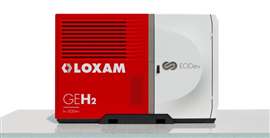 In 2022 Loxam acquired its first EODev GEH2 electro-hydrogen power generator as part of the company’s strategy to spend 25% of CapEx on low emissions equipment
In 2022 Loxam acquired its first EODev GEH2 electro-hydrogen power generator as part of the company’s strategy to spend 25% of CapEx on low emissions equipment
US-based rental company Herc Holdings says that it is currently in the process of calculating each of these categories and has so far estimated emissions for three of them to give a running total of 75,360mtCO2e in 2022.
“Scope 3 emissions include 15 categories of GHG emissions, of which we believe 10 to be significant to our operations,” Herc said. “To date we have estimated emissions of three of those categories including fuel sold to customers during rent and on-site refuelling, business travel and third party hauling between branches and customer jobsites. Our intention is to report on additional scope 3 emissions annually until we provide data for all 10.”
For rental companies, it is category #13 ‘downstream assets’ is the category in which most emissions are generated because it includes the emissions customers produce when using rental equipment.
UK-based Speedyhire reports that its greenhouse gas emissions statement for the 2022-23 financial year is limited to three of the 15 categories – waste disposal, transmission and distribution and employee commuting.
Ashtead Group, the parent company of Sunbelt Rentals has also voiced concerns about a lack of accuracy in scope 3 emissions data due to the difficulty in collecting some of it.
“Historically we have not reported Scope 3 emissions due to the difficulty in gathering accurate and reliable information,” the company said in its latest report. “We are working to quantify our scope 3 emissions so we can monitor these and report on them in the future. The majority of these arise through our customers’ use of our equipment on their sites and projects, emissions from the use of sold rental equipment subsequent to our ownership and the embedded carbon in our supply chain. Subsequently they are based on broad assumptions which are difficult to validate. Accordingly, our scope 3 emissions will always be subject to a significant degree of estimation uncertainty.”
Are scope 3 emissions reports accurate?
Certainly, the process of reporting carbon emissions is still open to a certain amount of interpretation.
Scope 3 emissions can be calculated using one of four different methods: asking customers and suppliers to provide the information based on their own carbon data; calculating emissions based on the amount of cash spent by customers or with suppliers; using telematics or other activity data to assess carbon emissions; or, most likely, a combination of all of these.
Moreover, for many of these calculations, companies are required to multiply spend or activity by an “emissions factor” to provide an estimate in metric tons of carbon dioxide equivalent – the standard measure for greenhouse gas emissions. There is no universal source of emissions factor and so companies must choose a suitable figure provided by government agencies, academic research, company reports or third-party standards organisations.
Loxam’s Conrad says that much of the data currently included in his company’s calculations currently comes from assumptions rather than actual working data, although he expects this to improve quickly as more telematics data from equipment becomes available.
“When talking about scope 3 emissions the level of uncertainty of the data is quite high for all companies,” he says. “We have assumptions for more than 1,000 categories of equipment in the group based on the data we have – e.g. the average number of hours used per day, the average consumption – and then we multiply that by a global emissions factor to get the total emissions. It’s based a little bit on IOT but it’s just at the beginning.
How can you reduce scope 3 emissions?
So, what can companies do to reduce scope 3 emissions? For those with the financial capability, the quickest option would be to replace diesel machines where possible with emissions-free alternatives.
Yet, for most companies this approach is not possible, partly because companies have spent years building up large legacy fleets.
Last year Loxam secured a €130 million ‘green loan’ from the European Investment Bank (EIB) which the company says it is using to accelerate the electrification of its fleet. The company says that in 2022, a quarter of company CapEx was directed towards low emissions equipment and the group hopes to increase this proportion to 50% by 2025.
Even with this heavy investment in emissions-free equipment, Loxam is still only committing to cutting its scope 3 emissions by 30% by 2030 compared with its 2019 baseline year.
“The backbone of our reductions target is based on the investment plan we have, to buy low-emission equipment. We only renew a small share of the fleet each year so at the moment only a few percent of the total fleet is ‘green’ equipment,” Conrad says. “But if we don’t start now then we will not be able to reach our targets for 2030 and beyond. And that is why we monitor what fleet we want to have in 2030 or 2035 and make assumptions on what technologies and prices will be available and we try to answer those questions now.”
Moreover, Conrad says that the process of encouraging customers to rent expensive emissions-free equipment rather than their cheaper diesel alternative will also take time.
“When we rent an electric excavator we don’t have to think that it’s the same as renting a diesel excavator,” he says. “When you rent green equipment you rent a full service, so we train people to make sure that you question customers about their use, how are you going to use this equipment. You have to take into account the cost of energy and the clean air regulations in towns and cities. So, it is a new way of renting equipment because you increase the level of service you provide around the equipment and this will take time because it’s money, it’s time, it’s training. This is why we will not change the way electric equipment is used tomorrow. It will take a few years.”
| Company | Scope 3 emissions target/information |
|
Aggreko |
Scope 3 emissions for 2022 stood at 9,077,379 mtCO2e, accounting for 99.4% of total emissions. Fleet accounted for 97% of emissions. Of which power generation accounted for by far the largest proportion (90.7%). The company has committed to a climate goal of reducing the emissions intensity of its energy solutions by 2030. |
| Ashtead Group |
Working to quantify scope 3 emissions in order to monitor and report on them in the future. |
| Herc Holdings |
Scope 3 includes 15 categories of GHG emissions, of which 10 are significant to Herc’s operations. To date it has estimated emissions of three of those categories including: fuel sold to customers during rent and on-site refuelling, business travel and third party hauling between branches and customer jobsites. Herc’s intention is to report on additional scope 3 emissions annually until data is provided for all 10. Total scope 3 GHG emissions (enterprise) stood at 75,360 mtCO2e in 2022, up from 51,306 in 2021. |
| Kiloutou |
Kiloutou reports total 2022 GHG emissions at 404,224CO2e of which scope 3 made up 93.31% 377.189 mtCO2e. Scope 1 made up 6.52% and scope 2, just 0.16%. The firm’s target is to reduce direct CO2 emissions by 40% between 2018 and 2030 and becoming carbon neutral by 2050. |
|
Loxam |
Loxam reports that in 2022 its total carbon footprint stood at 944,000 mtCO2e. Scope 3 emissions account for 95% of this total, equating to 896,800 mtCO2e. The company has pledged to cut direct emissions by 50% and scope 3 emissions by 30% by 2030 compared with a 2019 baseline year when its total carbon footprint stood at 938,000 mtCO2e. |
|
Modulaire |
Target to calculate its entire GHG inventory, including all scope 3 categories providing a 360-degree vantage of its emissions footprint, allowing it to set and track the company’s value chain impact and feed into the risk management process |
| SpeedyHire |
The company’s carbon footprint in 2020 stood at 270,000 mtCO2e of which scope 3 emissions accounted for 91% - 245,700 mtCO2e. Aim to reduce scope 3 emissions by 42% by 2030. |
| United Rentals |
Scope 1 and 2 and third party hauling emissions stood at 589,125mtCo2e, up from 535,758 in 2021 and 489,248 in the baseline year 2018. The firm’s goal is to reduce GHG emissions intensity across scope 1,2 and third party hauling within scope 3 by 35% by 2030 against a 2018 baseline. |
STAY CONNECTED



Receive the information you need when you need it through our world-leading magazines, newsletters and daily briefings.
CONNECT WITH THE TEAM
